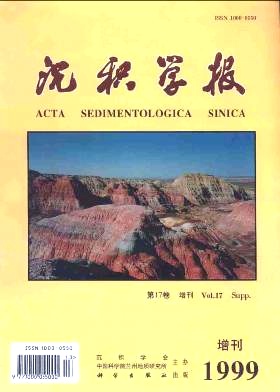HTML
| [1] | 1 Leggett J. The nature of the greenhouse threat in Global Warming [A]. The Green peace Report [C]. In; edited by J. Leggett J, ed. Oxford University Press,New York,1990. 14-43. 2 MacDonald G T. Role of methane clathrates in past and future climates[J]. Clim. Change,1990a,16: 247-281 3 Sloan Jr E D. Clathrate hydrate of natural gases [M]. Marcel Dekker,New York,1990. 286-386 4 Hunt J M. Petroleum Geochemistry and Geology[M]. W H Free-man San Fracisco,Calif,1979. 617 5 Yamamoto S,Alcauskas J B,Crozier T E. Solubility. Solubility of methane in distilled water and seawater[J]. J. Chem. Eng. Data,1976,21:78-80 6 Kevenvolden K A. Gas hydrate-geological perspective and global chage [J].Rev.Geophys, 1993,31:173-187. 7 Shipley T H,Houston M H,Buffler T R,Sharb F J, McMillen K J, Ladd J W,Wirzel J L. Seismic reflection evidence for the widespread occurrence of possiblegas一hydrate horizons on continental slopes and rises [J]. AAPG Bull 1979,63:2204-2213. 8 Yamano M S,Uyeda Y Aoki,Shipley T H. Estimates of heat flow derived from gas hydeates [J]. Geology,1982,10:339-343. 9 Hyndman R D, Davis E E .A mechanism for the formation of methane hydrate and seafloor bottom-simulating reflectors byvertical fluid expulsion [J]. J. Geophys .Res,1992, 97: 7025-7041. 10 Claypool G E,Kaplan I R. The origin and distribution of methane in marine sediments[A]. In;kaplan I R,ed. Natural Gases in the Marine Sediments[C]. Plenum,New York,1974. 99-139. 11 Goodman M A. Insitu gas hydrates:Past experience and exploitation concepts[R]. In ;proceedings 1 st International Gas Research Conference [C]. Government Institutes, Rockville, Md,1980. 376-391. 12 Collet T S, Kvenolden K A. Exploration for gas hydrates [J].I eoII.Kxpu,1990, (1) :8-14. 13 Mathews M. Logging characteristics of methane hydrate[J].Log Anal,1986,27(3):26-63. 14 Bernard B B,Brooks J M,Sackett W M. Natural gas seepage in the Gulf of Mexico [J]. Earth Planet. Sci. Lett,1976,31: 48-54. 15 Galimov E M,Kvenvolden K A. Concentrations and carbon isotopic compositions of CH4 and CO2 in gas from sediments of BlakeOuter Ridge,Deep Sea Drilling Project Leg 76. In;sheridan R E,et al, eds. Initial Reports of the Deep Sea Drilling PROJECT, vOL.76[J]. U. S. Government Printing Office,Washington, D C.1983. 403-407. 16 Claypool G W, Kvenvolded K A .Methane and other hydrocarbon gases in sediment samples from legsl0,11,13,14,15,18 and 19.In : Sholl D W, et al, eds lnitial Reports of the Deep Sea Drilling Project, Vol. 19[R]. U. S. Government Printing Office, Washing-ton,D C. 1973. 879-884. 17 Kvenvolden K A,Grantz A Gas hydrates of the Arctic Ocean region [A].In;Granta A. Johnson L,Sweeney J F,eds .The Gelolgy of North America, Vol. 1[C]. The Arctic ocean Region, Geological Society of America,Boulder,Colo. 1990. 539-549. 18 Kvenvoledn K A,Kastner M. Gas hydrates of the Peruvian outer continental margin. In; Suess E, ed. Proceedings of the Ocean Drilling Program, Scientific Results, Vol. 112 [R]. Ocean Drillingprogram,College Station,Tex. 1990. 517-526. 19 Hesse R,Harrison W E. Gas hydrates (clathrates)causing pore-water freshening and oxygen isotope fractionation in deep-water sedimentary sections of terrigenous continental margins[J]. Earth Planet. Sci. Lett,1981, 55 : 453-562. 20 Kevenvolden K A. Methane hydrate-A major reservoir of carbon in the shallow geosphere7 [J]. Chem. Geo1,1988a,71:41-51. 21 Sloan Jr E D. Natural gas hydrate phase equilibria and kinetics; understanding the state of the art Rev[J]. Inst. Fr. 1990b,45:245-266. 22 Holder G D,Kamath V A,Golbole S P. The potential of natural gas hydratesas an energy resource [J]. Ann. Rev. Energy,1984,9:427-445. 23 Miller J J, Lee M W, Von Huene R. An analysis of a seismic reflection fromthe base of a gas hydrate zone,offshore Peru [J].AAPG Bull, 1991,75:910-924. 24 Dillon W P, Grow J A, Paull C K. Unconventional gas hydrate seals may trapgas off southeast U. S[J]. Oil Gas J,1980, 78 (1):124-130 25 Makogon Yu F. Hydrate of nature gas[M]. pennwell,Tulsa,0k1a,1981. 237. 26 Kvenvolden K A, McMenamin M A. Hydrates of natural gas : A review of their geologic occurrence [J]. U. S. Geol. Surv. Circ.1980,825:11. 27 Collett T S. Potential of gas hydrates outlined[J]. Oil Gas 1. 1992,90(25) :84-87. 28 雷怀彦,王先彬等.天然气水合物研究现状与未来挑战[J].沉积学报,1999,17(3):493-498. |






 DownLoad:
DownLoad: